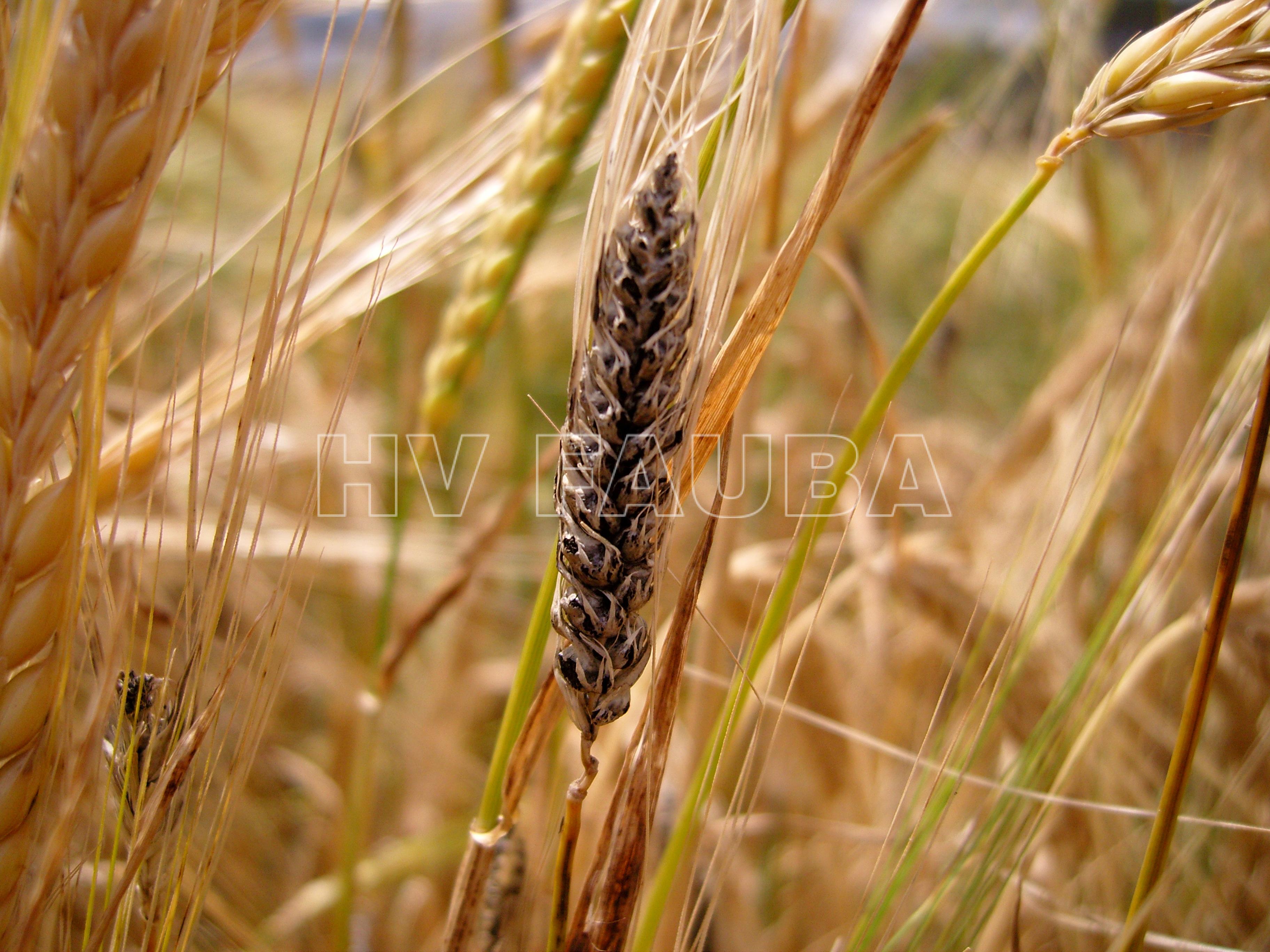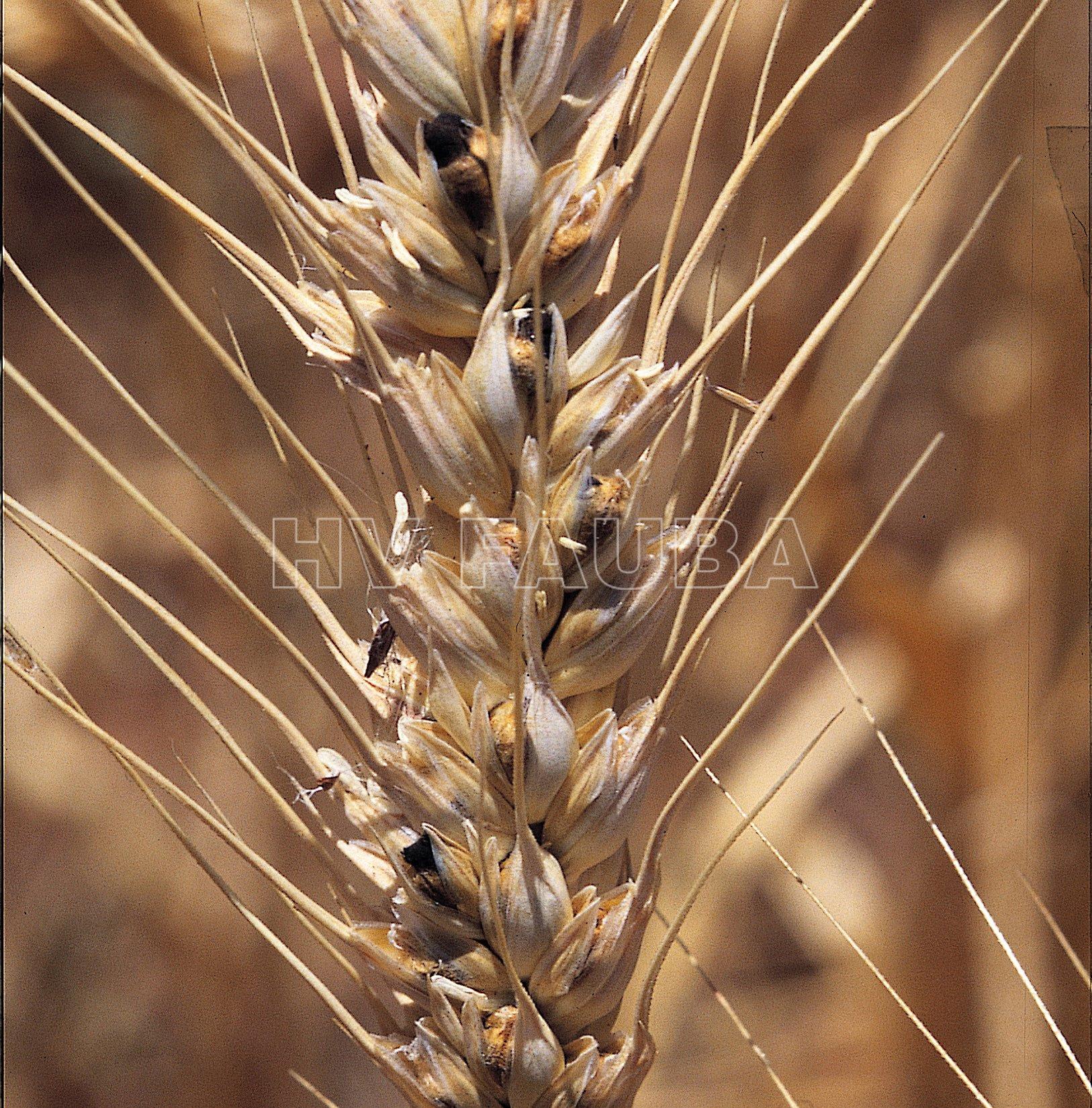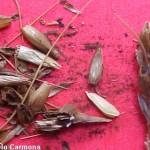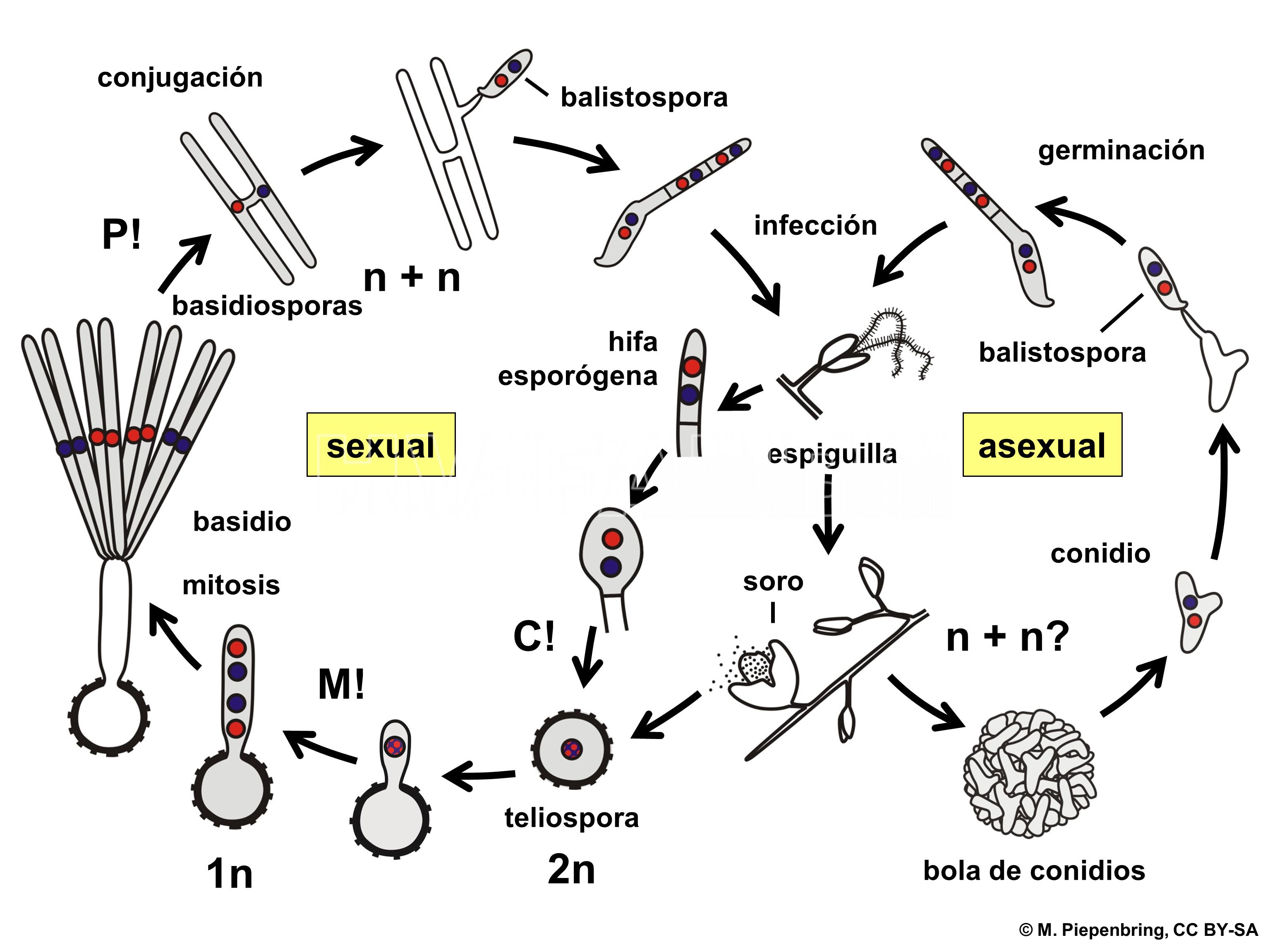.
Condición fitosanitaria: Presente
Grupo de cultivos: Cereales
Especie hospedante: Trigo (Triticum aestivum)
Rango de hospedantes: específico / estrecho
Epidemiología: monocíclica, subaguda.
Etiología: Hongo. Biotrófico
Agente causal: Tilletia laevis (Syn Tilletia foetida), Tilletia caries (Syn Tilletia tritici)
Taxonomía: Eukaryota > Fungi > Dikarya > Basidiomycota > Ustilaginomycotina > Exobasidiomycetes > Tilletiales > Tilletiaceae> Tilletia
.
.
.
Síntomas y signos
Los tejidos de la espiga se transforman en una masa pulverulenta de esporas negras (teliosporas). No hay granos y sólo queda el raquis. Se produce una destrucción parcial de la flor, permaneciendo las glumas. Los granos son reemplazados por una masa pulverulenta de esporas negras (teliosporas). En muchas ocasiones las espigas enfermas no se diferencias a simple vista de las sanas.
.
- Autor: Government of Western Australia.
- Autor: Government of Western Australia.
.
.
Daños
Puede ser considerada una enfermedad secundaria. Se presenta en la Región Pampeana con bajos valores de incidencia, sin generar daños significativos. Afecta la calidad comercial. En ciertos campos donde el curado de las semillas no es eficiente al no existir una buena cobertura del producto, puede haber mayores pérdidas.
.
Ciclo de la enfermedad
El patógeno es llevado externamente en las semillas. La infestación se produce durante la cosecha. Los granos infestados son llamado «punta negra» porque en la punta de la semilla (cepillo) están adheridas las esporas. Durante la germinación las esporas inician su crecimiento e infectan a las plántulas. En la espigazón, se puede observar los síntomas descriptos.
- Representación esquemática del ciclo del carbón cubierto del trigo, causado por especies de Tilletia spp. P! = plasmogamia; K! = cariogamia; M! = meiosis; 2n = células diploides; 1n = células haploides; n + n = células dicarióticas.
.
Factores de riesgo
Alto porcentaje de semillas infestadas.
.
Manejo
Utilizar semillas sanas o tratadas con funguicidas sistémicos. En laboratorio se puede determinar el nivel de infección en semilla. En relación al tratamiento de semillas, caben las mismas consideraciones que para el carbón volador, pero en este caso también se puede utilizar fungicidas protectores como el thiram.
.
.
.
Bibliografía
Alfaro M, Oguiza JA, Ramírez L, Pisabarro AG (2014) Comparative analysis of secretomes in basidiomycete fungi. J Proteomics. 102: 28-43. doi: 10.1016/j.jprot.2014.03.001
Begerow D, Stoll M, Bauer R (2006) A phylogenetic hypothesis of Ustilaginomycotina based on multiple gene analyses and morphological data. Mycologia 98(6): 906-16. doi: 10.1080/15572536.2006.11832620
Bonde MR, Peterson GL, Schaad NW (1997) Karnal bunt of wheat. Plant Disease 81: 1370–1377.
Forster MK, Sedaghatjoo S, Maier W, et al. (2022) Discrimination of Tilletia controversa from the T. caries/T. laevis complex by MALDI-TOF MS analysis of teliospores. Appl Microbiol Biotechnol 106: 1257–1278. doi: 10.1007/s00253-021-11757-2
Gupta AK, Goel A, Seneviratne JM, et al. (2011) Molecular Cloning of MAP Kinase Genes and In silico Identification of their Downstream Transcription Factors Involved in Pathogenesis of Karnal bunt (Tilletia indica) of Wheat. Journal of Proteomics & Bioinformatics 4: 160–169. Link
Gurjar MS, Aggarwal R, Jogawat A, et al. (2019) De novo genome sequencing and secretome analysis of Tilletia indica inciting Karnal bunt of wheat provides pathogenesis-related genes. 3 Biotech 9: 219. doi: 10.1007/s13205-019-1743-3
Iqbal M, Semagn K, Jarquin D, et al. (2022) Identification of Disease Resistance Parents and Genome-Wide Association Mapping of Resistance in Spring Wheat. Plants 11(21): 2905. doi: 10.3390/plants11212905
Kumar J, Nagarajan S (1998) Role of Flag Leaf and Spike Emergence Stage on the Incidence of Karnal Bunt in Wheat. Plant disease 82: 1368–1370.
Kumar A, et al. (2017) Draft genome sequence of Karnal bunt pathogen (Tilletia indica) of wheat provides insights into the pathogenic mechanisms of quarantined fungus. PLoS ONE 12(2): e0171323. doi: 10.1371/journal.pone.0171323
Pandey V, Singh M, Pandey D, Kumar A (2018) Integrated proteomics, genomics, metabolomics approaches reveal oxalic acid as pathogenicity factor in Tilletia indica inciting Karnal bunt disease of wheat. Scientific Reports 8: 7826. doi: 10.1038/s41598-018-26257-z
Pandey V, Singh M, Pandey D, et al. (2018) Secretome Analysis Identifies Potential Pathogenicity/Virulence Factors of Tilletia indica, a Quarantined Fungal Pathogen Inciting Karnal Bunt Disease in Wheat. Proteomics 18(8): e1700473. doi: 10.1002/pmic.201700473
Pandey V, Gupta AK, Singh M, et al. (2019) Complementary Proteomics, Genomics approaches identifies potential pathogenicity/virulence factors in Tilletia indica induced under the influence of host factor. Sci Rep 9: 553 . doi: 10.1038/s41598-018-37810-1
Rana M, Arora C, Ram B, Kumar A (2001) Floral specificity of Karnal bunt Infection Due to Presence of Fungal Growth Promotory Activity in Wheat Spikes. Journal of Plant Biology 28: 283–290.
Ren Z, Fang M, Muhae-Ud-Din G, et al. (2021) Metabolomics analysis of grains of wheat infected and noninfected with Tilletia controversa Kühn. Sci Rep 11: 18876. doi: 10.1038/s41598-021-98283-3
Ren Z, Zhang W, Wang M, et al. (2021) Characteristics of the Infection of Tilletia laevis Kühn (syn. Tilletia foetida (Wallr.) Liro.) in Compatible Wheat. Plant Pathol J. 37(5): 437-445. doi: 10.5423/PPJ.OA.05.2021.0082
Sedaghatjoo S, Mishra B, Forster MK, et al. (2022) Comparative genomics reveals low levels of inter- and intraspecies diversity in the causal agents of dwarf and common bunt of wheat and hint at conspecificity of Tilletia caries and T. laevis. IMA Fungus 13: 11. doi: 10.1186/s43008-022-00098-y
Seneviratne JM, Gupta A, PandeyD, et al. (2009) Determination of genetic divergence based on DNA markers amongst monosporidial strains derived from fungal isolates from Karnal bunt (Tilletia indica) of wheat. Plant Pathology Journal 25: 303–316. doi: 10.5423/PPJ.2009.25.4.303
Ullmann L, Wibberg D, Busche T, et al. (2022) Seventeen Ustilaginaceae High-Quality Genome Sequences Allow Phylogenomic Analysis and Provide Insights into Secondary Metabolite Synthesis. J Fungi (Basel) 8(3): 269. doi: 10.3390/jof8030269
Weed RA, Savchenko KG, Lessin LM, et al. (2021) Untargeted Metabolomic Investigation of Wheat Infected with Stinking Smut Tilletia caries. Phytopathology 111(12): 2343-2354. doi: 10.1094/PHYTO-09-20-0383-R
Wolde M, Du Z, Muhae-Ud-Din G, et al. (2023) Histological changes at the seedling growth (Z12) and stem elongation (Z31) stages after Tilletia controversa infection. Trop. plant pathol. 48: 174–181. doi: 10.1007/s40858-023-00555-y
Zuo W, Ökmen B, Depotter JRL, et al. (2019) Molecular Interactions Between Smut Fungi and Their Host Plants. Annual Review of Phytopathology 57: 411-430. doi: 10.1146/annurev-phyto-082718-100139



